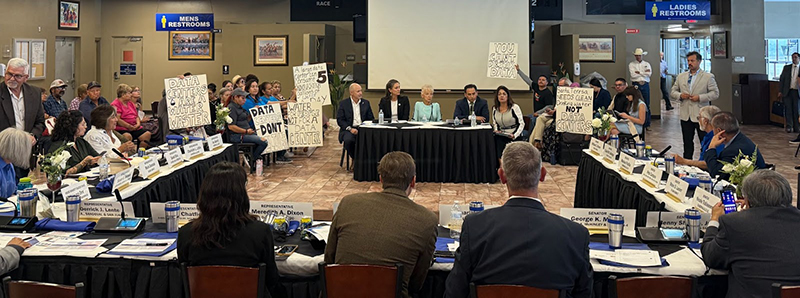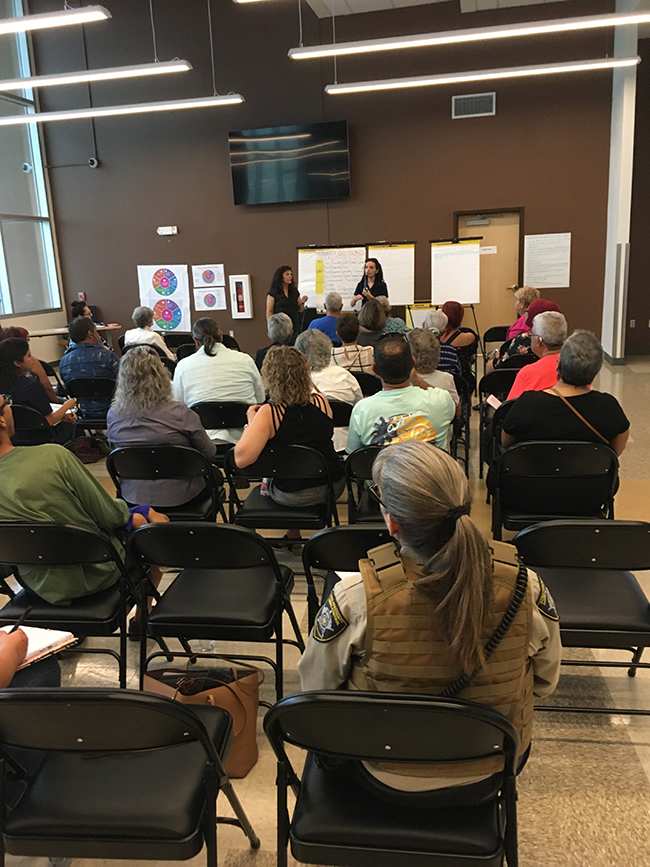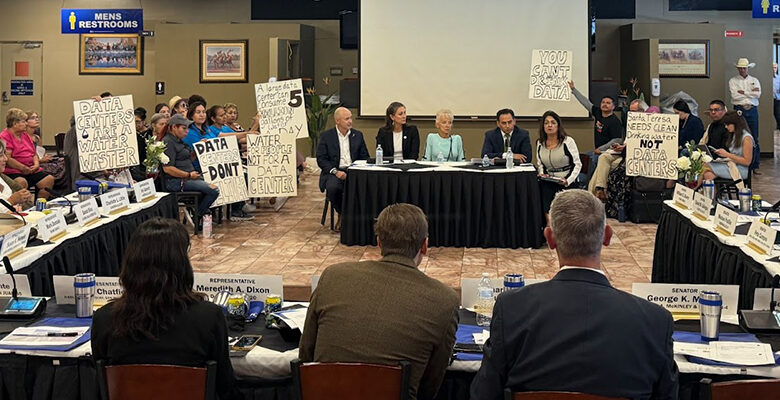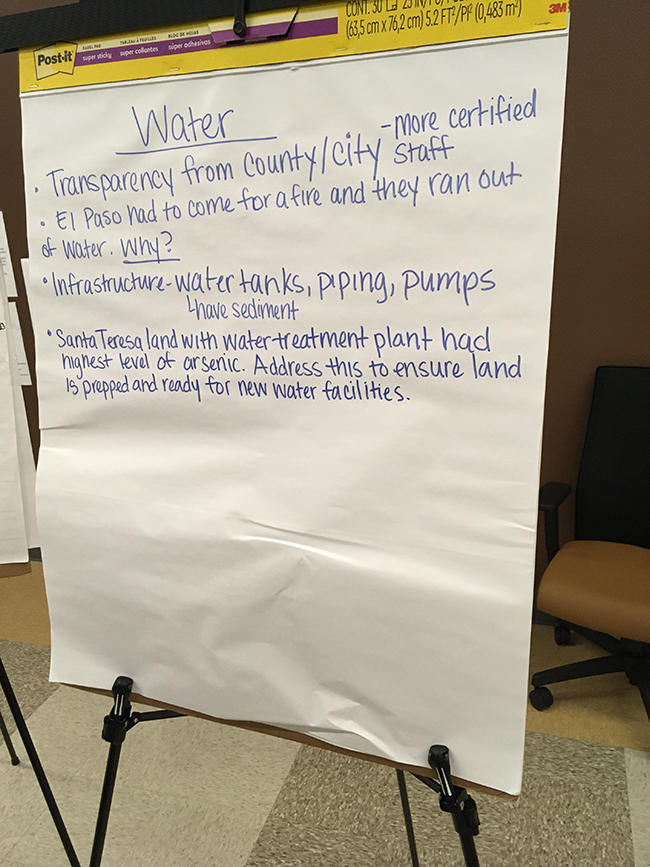By Kent Paterson

You may or may not have heard about Project Jupiter by now. No, it’s not the latest scheme by Elon Musk to populate a far-off planet with the golden elite of the human race. It’s an uber-sized development plan for the border industrial zone of Santa Teresa, New Mexico.
Dissecting the planned development is well beyond the scope of one article, but here are a few basics.
Steered by Stack Infrastructure and BorderPlex Digital Assets, a company headed by Texas businessman Lantham Napier, Project Jupiter intends to seed a sprawling industrial complex that will showcase a multi data center utilizing artificial intelligence. The developers promise that building and opening the new campus will create “thousands of construction and operations jobs, with local hiring.”
In an August 26 presentation to the Doña Ana County Board of County Commissioners, Napier said the data centers alone would create 700 permanent jobs. In addition to data processing, the development envisions the “advanced manufacturing” of domestic chips, batteries, precision machinery and more.
Project Jupiter’s commanders pledge to invest upwards of $165 billion over 20 years. That’s billion, not million. The money will be raised via Industrial Revenue Bonds (IRBs), which are essentially loans from other investors issued by local or state governments but paid back by the recipient
For the past couple of years, promoters have lined up their ducks in strategic order to make sure Project Jupiter gets a successful lift off from the ground. Last February, New Mexico Governor Michelle Lujan Grisham announced a $5 billion partnership with the Texas-based company, opening the welcoming doors and good offices of state agencies, higher educational institutions and even local governments. And the initiative counts on Rodey Law Firm one of the state’s most prestigious legal outfits, to bolster the cause.
In reaching for the stars, BorderPlex Digital Assets identifies many complementary “assets” for a New Mexico launching pad and operational base, including scientists at Los Alamos and Sandia national labs, workforce developers at New Mexico State University and Doña Ana County Community College, and a host of friendly folks from local and state government. El Paso Electric is also another valuable piece on the chessboard.
According to the company, a “welcome political environment and government that wants to work closely with you” prevails in the Land of Enchantment. Indeed.
Officials from Doña Ana County and the State of New Mexico are poised to offer significant tax breaks and subsidies to Project Jupiter, all with the premise that the high-paying jobs and added economic output generated by the development will generate more economic activity and, ultimately, greater tax revenue.
August 2025 was an especially busy and critical month for Project Jupiter’s fortunes, with BorderPlex Digital Assets presenting its case to the powerful New Mexico State Legislative Finance Committee (LFC) as well as state, local and Mexican political and economic leaders in Sunland Park and Las Cruces on August 19 and 20, respectively. From the get go, this big economic engine revving up has international rumblings.
The selection of Santa Teresa for Project Jupiter’s gargantuan campus is no accident. The promoters are catching a wave off the big one that’s recently visited New Mexico’s biggest international port of entry and 21st century industrial hub.
Recent statistics compiled by the pro-Santa Teresa development Border Industrial Association (BIA) and presented to the New Mexico LFC portray how a cattle crossing that first opened in 1991 has evolved into an economic powerhouse. According to the report, 80 companies now operating in Santa Teresa employ 7,000 people.
Recently quoted in an article by the Federal Reserve Bank of Dallas, BIA President Jerry Pacheco said 78 of the 80 companies are from either from out of state or foreign nations. Their products encompass electronics, telecommunications, automotive components, metal stamping, plastic injection and food processing.
Four companies operating right across the border in San Jeronimo, Chihuahua, employ 10,000 plus workers, mainly at the giant Foxconn plant. In 2024, Santa Teresa chalked up $39.4 billion in import and export activity, a whopping 44 percent increase from 2023 and an annual surge far surpassing the other U.S. ports of entry along the U.S-Mexico border. Oh, and the cattle crossing is still hopping. Averaging more than 500,000 animals every year, that facility handles 20 percent of all U.S. livestock imports, according to the BIA.
The year 2024 was the “absolute best year we’ve ever had,” Pacheco told the Dallas Federal Reserve. “We’re finally achieving what I dreamt of 30 years ago: that we could be a major economic pillar of the New Mexico economy. It’s come true.”
Jobs, Jobs, Jobs and Money, Money, Money
Project Jupiter’s promoters gave an overview of their game plan to the August 26 regular session of the Doña Ana County Board of Commissioners in Las Cruces, where the elected officials voted 4-1 to advance the passage of an IRB ordinance that will facilitate launching the development. Voting in favor of the motion were Commission Chair Christopher Schaljo-Hernandez and fellow Commissioners Shannon Reynolds, Manuel Sanchez and Gloria Gameros.
Commission Vice-Chair Susana Chaparro voted no, saying that even after two personal meetings with Project Jupiter’s leaders, she still had unanswered questions. “My constituents direct my vote…,” Chaparro said. “It sounds beautiful, but it has to be done in a right way.”
As in the previous August meetings, protestors from the grassroots Empowerment Congress of Doña Ana County and others turned out to voice their concerns about water and energy consumption by data centers, the impact of big property tax breaks, and the transparency (of lack thereof) of elected governments and their dealings with big money developers.
Data centers use enormous amounts of water to keep their information flowing, and in the case of Project Jupiter the company proposes to draw up brackish groundwater from a depth of 2,500 feet below the desert floor of Santa Teresa and clean it up in a desalination plant. While technically feasible, desalination plants don’t come cheap.
Promoters claim that “an integrated design that will help protect local power and water resources while supporting the infrastructure needed.”
Well attended, the livestreamed Las Cruces County Commission meeting attracted dozens of proponents and opponents of the envisioned Santa Teresa megaproject.
If an IRB ordinance is approved and the project takes off, county property taxes would be exempted for up to 30 years. Additionally, Project Jupiter is expected to receive generous support from the State of New Mexico in the form of rebates on Gross Receipts Taxes paid for specified equipment purchases and job-training grants, among other possible incentives and subsidies.
In return, the company offers to directly pay Doña Ana County $300 million during a 30-year span in special payments called PILOTS.
Project Jupiter’s boosters were given the first words at the August 26 meeting of Doña Ana County Commissioners.
Lauren Sanchez, Albuquerque-based attorney for Rodey Law, began her comments in Spanish and then translated them in English, describing her family roots in Deming and the Paso del Norte.
“I really think that this is an important opportunity for the region to invest in the future in an important area that’s not going away at all. It’s only growing and increasing,” Sanchez said.
Lantham Napier, co-founder and chair of Borderplex Digital Assets, termed Doña Ana County a special place that is sitting at the “intersection at the nexus of two countries and a couple of states that for generations and hundreds of years this has been a vital trade corridor up from Mexico into what is now known as the U.S., New Mexico and Texas.”
As an example of what awaits Doña Ana County, the Texas entrepreneur and developer pointed to Meta’s (controversial) data center in Los Lunas, New Mexico, charactering it as a “transformative outcome for the community.”
Napier further pledged that Project Jupiter won’t result in higher energy and water costs for locals, and that there would be community engagement in the “north of $300 million” PILOT direct payments to the county.
Of 21 people who offered public comment to the commissioners, 11 were against the IRBs and Project Jupiter, 8 firmly in favor and 2 desiring more information and transparency.
New business for local contractors, higher paying jobs, and retaining young people who look outside the Paso del Norte for career opportunities were themes sounded by proponents.
Davin Lopez, president of the Mesilla Valley Economic Development Alliance, urged the commissioners to take advantage of a historic window.
“The last thing I want to do is chase away jobs now and tax increase opportunities for Doña Ana County, because we’re not going to do get it from the federal government, Lopez said.
The New Mexico Economic Development Department’s Julia Brown, former Sunland Park city manager, asserted that Project Jupiter “can serve to be a catalyst for spin-off development. The project is going to offer good-paying jobs for New Mexico residents.”
Daniel Nelson, supervisor for Dona Ana County Water and Soil Conservation District, contrasted the pay Borderplex Digital Assets vows Project Jupiter’s permanent workers will earn with the average county income. “$75,000, $55,000, it’s up to you guys,” Nelson said.
“Yes! boomed one man. “Seize the day!”
On the other hand, opponents expounded myriad reasons why an IRB ordinance should be nipped in the bud, touching on issues ranging from environmental sustainability and economic rationality to personal privacy and human rights. One speaker raised the specter of nuclear energy being harnessed for operations.
Another young man contended that the artificial intelligence generated in a data center could be bought and sold by the Department of Homeland Security, ICE and the Border Patrol or even sold to contractors that sell weapons to Israel and commit genocide against Palestinians. “This is a huge security risk for the residents of our country,” he declared.
Daisy Maldonado, Empowerment Congress of Doña Ana County director, criticized Lantham Napier for repeating the same message of “jobs, jobs, jobs, money, money, money, sign on the dotted line, give us this inducement” at meetings including one with the Empowerment Congress.
“New Mexico is not going to be a guinea pig no more,” said Sunland Park’s Jose Saldana. “All these private companies, they make money and leave after 15 years. After 15 years, what’s going to happen? We’re going to be a in a worse hole.”
Holding a placard that read “You Can’t Drink Data.” Kacey Hovden, staff attorney with the New Mexico Environmental Law Center, similarly called attention to the non-local interests of the developers. “They’re not from New Mexico. They’ll take their profits and leave,” Hovden said. She added that Project Jupiter’s leaders incorporated different (LLC) companies in Delaware to handle any future IRBs only a week-and-a-half before the August 26 meeting, giving some names like Red Chili Ventures and Green Chile Ventures to make them appear New Mexican when they are not.
The New Mexico Environmental Law Center is waging a write-in campaign to Doña Ana County Commissioners urging the public before September 9 to write elected officials in support of a no vote on the IRBs.
“Please, please, take your time,” pleaded one woman to the county commissioners. “Do your due diligence.”
On September 19, the Doña Ana County Board of Commissioners will conduct a public hearing in Las Cruces before voting on whether to authorize the issuance of IRBs totaling $165 billion. Yes, that’s $165 billion.

GO, GO, GO
Taxes, water and development sizzle as burning issues on other fronts in Doña Ana County as well. Earlier, on August 11, dozens of concerned residents gathered at the Sunland Park Sports Complex to learn about Doña Ana County’s proposed GO Bonds (General Obligation Bonds) that are employed to finance new entertainment and recreational facilities, community centers, internet Broadband, roads, and water and wastewater infrastructure.
District 2 County Commissioner Gloria Gameros hosted the event, along with participation from Doña Ana County Assistant Manager Jonathan Macias and Rosie Natividad of the Incite Network, a county partner that assists with planning and grant acquisition.
Successful GO Bond financing is contingent upon voter approval in the upcoming November 4 election. Essentially, these bonds are loans taken out by the county government and paid back to investors over time.
The Sunland Park meeting was among several centered on the GO Bonds that Gameros had scheduled in her district during the month of August, as did other county commissioners conducted similar events in their districts. Gameros said her first meeting was convened a week earlier in the village of Vado, where about 75 people turned out but, understandably, wanted to focus on the devastating July flooding that struck the small community located off Interstate 10 between Las Cruces and El Paso.
At the August 11 meeting, residents learned that if the $140 million GO Bond package is approved, the borrowed money will be paid back for the first time through a property tax hike in Doña Ana County. According to a handout passed out to attendees, the increase will vary depending on the value of a taxpayer’s property. The breakdown is as follows:
– $85,000 market value property=$4.34 monthly or $52.09 annually
– $285,000 market value property=$14.56 monthly or $174.67 annually
– $485,000 market value property=$24.77 monthly or $297.24 annually
Payment of the GO Bonds will take 20 years, after which the specific property tax increase will be removed from taxpayers’ bills, according to Doña Ana County.
The Water Question Flares-Again and Again
Gameros’ Sunland Park community meeting was a lively event punctuated by questions and answers, commentaries, polemics and a poll taken by the Commissioner. One man asked why a tax increase was necessary given that cannabis sales were racking up buku bucks in Sunland Park.
Macias, who said he grew up in Sunland Park, responded that the Gross Receipts Tax charged on cannabis sales goes into New Mexico state government coffers, and it is the state government which is then decides how the proceeds are spent.
As the evening progressed, meeting attendees helped sketch out specific areas where bond money could be spent and then voted on priorities with a show of hands. The results were as follows:
-new or upgraded parks=0
-entertainment=0
-new indoor recreational centers=9
-roads=11
-new or upgraded county services centers=17
-new or upgraded community centers=18
-water and wastewater=20
In a community beleaguered by historic problems of water infrastructure and quality it’s no surprise that water was tagged as the most important priority at the August 11 Sunland Park meeting.
Of course, it’s up to Doña Ana County voters to decide if the GO Bonds get the green light. Many questions frame the potential success or failure of the bonds in a local, off year election. First of all, will many voters turn out? What will be the Trump Effect- if any- on this local election? How will ongoing inflation and dissatisfaction over existing property taxes shape voters’ sentiments? Many residents of Doña Ana County are senior citizens who confront escalating Medicare Part B premiums and other rising healthcare expenses. Will Project Jupiter fall out prove a wild card?
Meantime, Dona Ana County government has announced a series of community meetings about Project Jupiter in the coming days. The schedule is as follows:
La Mesa Community Center
744 San Jose Rd. La Mesa, NM 88044
Date: Friday, September 5, 2025
Time: 5:30 p.m.
Doña Ana Community College East Mesa Campus
2800 Sonoma Ranch Las Cruces, NM 88011
Date: Monday, September 8, 2025
Time: 5:30 p.m.
Doña Ana Community College Sunland Park Center
3365 McNutt Road Sunland Park, NM 88063
Date: Tuesday, September 9, 2025
Time: 5:30 p.m.
In other related news, the Sunland Park City Council will convene in a special meeting scheduled for at 9:30 am on Tuesday, Sept. 9. Councilors will consider a resolution authorizing the City Manager and staff to coordinate with Doña Ana County Commissioners and the New Mexico Economic Development Department in an assessment of the “impacts” of Project Jupiter. The hybrid meeting will take place in the City Council’s chamber located at 1000 McNutt Rd. Suite A in the municipal government complex.
Members of the public can also participate either online or by phone:
Online: Microsoft Teams
Meeting ID: 256 783 243 866
Passcode: sHSmhJ
Dial in by Phone
+1 323-705-3503
Phone conference ID: 277 577 194#


